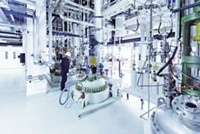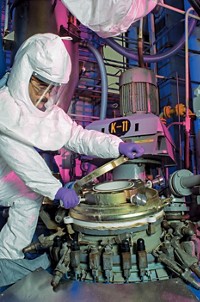Advertisement
Grab your lab coat. Let's get started
Welcome!
Welcome!
Create an account below to get 6 C&EN articles per month, receive newsletters and more - all free.
It seems this is your first time logging in online. Please enter the following information to continue.
As an ACS member you automatically get access to this site. All we need is few more details to create your reading experience.
Not you? Sign in with a different account.
Not you? Sign in with a different account.
ERROR 1
ERROR 1
ERROR 2
ERROR 2
ERROR 2
ERROR 2
ERROR 2
Password and Confirm password must match.
If you have an ACS member number, please enter it here so we can link this account to your membership. (optional)
ERROR 2
ACS values your privacy. By submitting your information, you are gaining access to C&EN and subscribing to our weekly newsletter. We use the information you provide to make your reading experience better, and we will never sell your data to third party members.
Business
Fine Chemicals: Cautious Optimism Washes Over Sector
by Rick Mullin
January 12, 2012
| A version of this story appeared in
Volume 90, Issue 2

The fine chemicals sector was strong in 2011, with many companies claiming to have rebounded from losses incurred in 2009 and 2010. Producers remain optimistic about 2012 but mix, as usual, a good dose of caution with that optimism in a market that historically experiences sudden ups and downs.
COVER STORY
Fine Chemicals: Cautious Optimism Washes Over Sector
Companies that in the past two years invested in new technologies—ranging from high-potency active pharmaceutical ingredient (API) manufacturing to finished-dose drug formulation—are counting on their investments to kick in as growth engines in 2012. Others are looking to build on rebounding nonpharmaceutical businesses. For example, Lonza acquired Arch Chemicals last year in an effort to take the top position in microbial control.
Michael Reinhard, Lonza’s head of key accounts management for North America, reports that the fine chemicals business is picking up in the U.S. “It’s mostly in the early stage,” he says, referring to the small quantities of APIs needed at the start of the drug development process. Likewise, David Ager, principal scientist at DSM, says he sees increased activity in pharmaceutical company R&D pipelines.
At Cambrex, CEO Steven M. Klosk expects the company to report 5–7% growth in 2011. “There is a strong backlog for our generic APIs,” Klosk says. Business is slower on the branded-drug side. Klosk says he is enthusiastic about Cambrex’ finished-dosage facility in Hyderabad, India, where the company is producing the API and finished product for a nicotine replacement drug.
The exit of major drug companies from manufacturing continues to drive business for fine chemicals makers. But Aslam Malik, president of Ampac Fine Chemicals, cautions that a rise in outsourced production of established or generic drugs may not mean increased business for Western API suppliers, since much of that production will go to China.
A more solid upside, Malik says, lies in the uptick in drug approvals by FDA in 2011. The active ingredients in newer products are generally potent and complex, meaning lower volumes but more specialized manufacturing technology.
More rigorous supply chain management on the part of pharmaceutical companies should benefit Western API makers, with drug companies instituting policies of establishing a Western backup to any key product manufactured in Asia. Some fine chemicals companies say business is coming back from China, in particular, because of quality concerns and Asia’s eroding cost advantage.




Join the conversation
Contact the reporter
Submit a Letter to the Editor for publication
Engage with us on Twitter